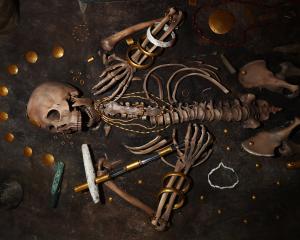An Olveston window shines a light on cultural influences of the time, writes Jenny Longstaff.
Olveston's numerous stained-glass windows are an attractive feature.
A small image (designed by G. F. Malins of London) in the billiard room bay window, portrays the mythological Green Man, a forest sprite figure which has featured in many cultures through the centuries, usually interpreted as a connection with the cycle of nature.
The oak leaf in his mouth references the sacred Druid groves of ancient times.
The G. F. Malins-designed windows were made by the grisaille technique, known in Europe since the 13th century, whereby the glass surface is coloured by applying silver sulfide or silver chloride, which is then fired at a relatively low temperature and imparts a greyish to yellowish stain.
In the 19th century, tin stencils were used to create the grisaille patterns.
The technique, basically painting on glass, did not require lead borders.
In the accompanying photographs, note the similarity of some aspects of the face in the Olveston window and in the Pan magazine cover of April/May 1895 (illustrated by Franz von Stuck): the brows and eyes, the forked beard and curved shapes at the side of the head.
Pan was an arts and literary magazine, published from 1895 to 1900 in Berlin.
It took its name from the ancient Greek god of shepherds and flocks, of mountain wilds, hunting and rustic music.
In the late 19th century, the figure of Pan became increasingly common in art and literature, appearing in poetry, novels and children's books.
J. M. Barrie's Peter Pan character first appeared in 1902.
Pan, the magazine, played an important role in the development of the Art Nouveau movement in Germany (Jugendstil), a style typified by elegant designs of flowing, sinuous organic forms in the decorative arts and architecture.
David Theomin, of Olveston, was a well-read man with German connections.
Being interested in the arts, he was probably familiar with this magazine.
Was the window commissioned by him?
Or perhaps it was arranged by Olveston's British architect, Sir Ernest George (1839-1922), given his interest in supervising decor design details.
- Jenny Longstaff is a housekeeper and tour guide at Olveston Historic Home.












